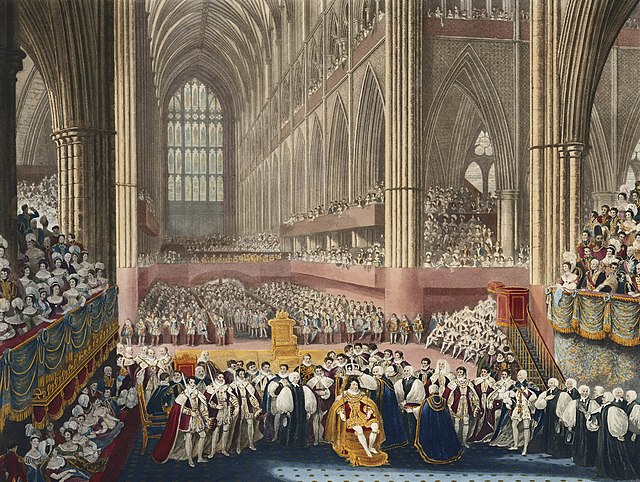The coronation of George IV as King of the United Kingdom took place at Westminster Abbey, London, on 19 July 1821. Originally scheduled for 1 August of the previous year, the ceremony had been postponed due to the parliamentary proceedings of George's estranged wife, Queen Caroline; because these failed to deprive Queen Caroline of her titles and obtain a divorce from the King, she was excluded from the ceremony. In accordance with George's lavish personal tastes, the coronation was the most extravagant ever staged and a number of the traditional elements of the ceremonial were conducted for the last time.
King George IV in his coronation robes, by Sir Thomas Lawrence, 1821
George IV with the train of his robe being carried by eight sons of peers and the Master of the Robes
An artist's impression of Queen Caroline and Lord Hood being refused entry to the abbey by a doorman
The moment of George's crowning at Westminster Abbey
Coronation of the British monarch
The coronation of the monarch of the United Kingdom is an initiation ceremony in which they are formally invested with regalia and crowned at Westminster Abbey. It corresponds to the coronations that formerly took place in other European monarchies, which have all abandoned coronations in favour of inauguration or enthronement ceremonies. A coronation is a symbolic formality and does not signify the official beginning of the monarch's reign; de jure and de facto their reign commences from the moment of the preceding monarch's death or abdication, maintaining legal continuity of the monarchy.
George VI receiving the homage after being crowned in 1937; watercolour by Henry Charles Brewer
Coronation of Harold II at Westminster Abbey in 1066, from the Bayeux Tapestry
Coronation of Henry IV at Westminster Abbey in 1399
Alexander III of Scotland at his coronation aged eight at Scone Abbey in 1249, being greeted by the royal poet who will recite the king's genealogy








